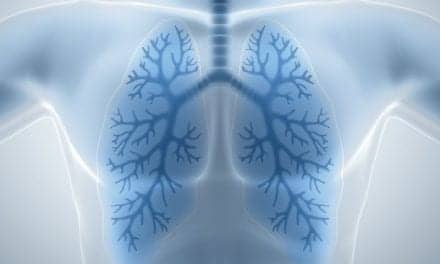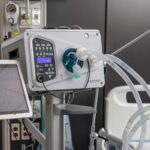Changes in lung function are of critical importance to patients with cystic fibrosis (CF), as lung function is a key indicator of disease progression and treatment effectiveness.
By Bill Pruitt, MBA, RRT, CPFT, FAARC
Changes in lung function are of critical importance to patients with cystic fibrosis (CF), as lung function is a key indicator of disease progression and treatment effectiveness. This article will briefly discuss an overview of CF, the use of pulmonary function testing to assess, monitor and manage CF care, therapy and medications that are available to treat CF, and patient education efforts to identify early signs of the disease.
Cystic Fibrosis and the CFTR Gene
CF is an inherited disease and is caused by a mutation in the CF transmembrane conductance regulator gene (CFTR gene). CF follows an autosomal recessive inheritance pattern – when both parents of a child are carriers of a normal CFTR gene along with an abnormal gene (but neither has the disease) there is a 25% chance inheriting the disease with every pregnancy. If one parent is a carrier and the other is not, there is a 50% chance of a child being a carrier of the abnormal gene. (Normally a CF carrier will be asymptomatic but some will experience mild symptoms).1
Although approximately 3,000 individual mutations have been identified, currently, CF is classified into five types based on the CFTR mutation’s impact on protein production. Pharmacological therapies are available (or in development) to address the particular category of CF.2 These categories are:
- Class 1: Protein production mutations
- Class 2: Protein processing mutations
- Class 3: Gating mutations
- Class 4: Conduction mutations
- Class 5 Insufficient protein mutations
CF causes pathologic changes in several organ systems, including both the upper and lower respiratory tract, pancreas, gastrointestinal tract, and the male reproductive tract (although mild cases or asymptomatic cases may occur and can later move to a more defined presentation).3 It causes persistent infections, bronchiectasis, and fibrotic scarring in the lungs, pancreatic insufficiency and fibrosis, malnutrition, anemia, reduced bone mineral content (with increased rates of fractures and kyphoscoliosis) and high sweat chloride levels (≥60 mmol/L).3,4 The sweat chloride test is the primary test for detecting CF (normal results for the sweat chloride test is ≤29 mmol/L).
CF causes problems with the transport of chloride and other ions (i.e. sodium and bicarbonate) which leads to thick, viscous secretions that affect the lungs, pancreas, liver, intestine, and reproductive tracts. Diagnosis is confirmed by finding a genetic and/or functional abnormality in the CFTR gene. It is found world-wide, and in the USA population, it is most prevalent in White Americans (1 in 3,200), followed by Hispanic Americans (1 in 10,000) then Native Americans (1 in 10,500), Black Americans (1 in 15,000), and finally, Asian Americans (1 in 30,000).3 With the increase in newborn screening (now routinely performed in all 50 states), early detection of CF has increased greatly and with early intervention there has been improved lung function, improved neurocognitive testing scores, and better nutrition later in life, along with a reduction in use of healthcare resources.
CF Issues in the Pulmonary System
Patients with CF generally have a persistent, productive cough with purulent sputum that is hard to clear, hyperinflation in the chest radiograph, and pulmonary function tests reflecting obstructive airway disease. Infants often have cough, wheezing, and breathing difficulties. With progression of the disease, patients develop chronic bronchitis frequent infections that lead to bronchiectasis, clubbing in the digits (with moderate to advanced disease), malaise, anorexia, and weight loss.3,5 Over time patients often have chronic airway infection with either Staphylococcus aureus or gram-negative bacteria, and P. aeruginosa is ultimately found in the respiratory secretions of most patients. In the upper airway, 10 to 32 percent of patients will have nasal/sinus polyps as a result of chronic rhinosinusitis.3,5 Symptoms may differ between patients and symptom-onset may not begin until adolescence or even adulthood.
Pulmonary Function Tests for CF Patients
Spirometry and lung volume measurement are the first tests in the battery of pulmonary function testing when monitoring lung disease. Early findings in spirometry show reduced obstruction in the small airways and reduced airflow at lower lung volumes – seen in the forced expiratory flow between 25 and 75% of the FVC (FEF25-75%). Lung volumes (measured by body plethysmography) show gas trapping in an increase in the ratio of the residual volume to total lung capacity (RV/TLC). As the disease progresses there is an increasing drop in the forced expiratory volume in the first second of exhalation (FEV1), followed by a decreased forced vital capacity (FVC). The FEV1 is considered to be the prime indicator for disability is linked to predicting length of survival.5
Gas trapping can also be assessed by measuring the lung clearance index (LCI) by using a multiple breath nitrogen washout test (MBNW). Body plethysmography can be challenging for a child to perform correctly while the MBNW may be easier to perform. The MBNW test uses nitrogen as a tracer gas. During the testing the individual breathes 100% oxygen through a closed circuit and the test measures the volume of each breath along with the exhaled nitrogen that is being washed from the pulmonary system. The subject is coached to use a normal tidal breathing pattern (normal rate and tidal volume). The test continues until the nitrogen concentration drops to 2.5%. The functional residual capacity (FRC) and LCI can be determined with this test and these measurements will increase as the disease progresses.4
Likewise, in young children, performing spirometry testing may be difficult. Impulse oscillometry is another approach that is being used to access the resistance and reactance of the central and peripheral airways.4 The impulse oscillometry system (IOS) uses a normal tidal breathing pattern and applies pressure waves at specific frequencies (ranging from 5 to 35 Hz) to generate vibrations in the airways. The oscillations of the airways produced by the vibrations are recorded and analyzed to provide details on resistance and reactance and can also show changes from pre/post bronchodilator therapy.4 Both the MBNW test and the IOS results can show early changes in the small peripheral airways that is not yet detectable by spirometry and are easier tests to perform in children.
Treatment for CF
Tenacious, hard-to-clear secretions cause frequent infections, inflammation and damage to the airways, and can lead to bronchiectasis, airflow obstruction, hypoxemia, and (in cases with severe airway disease) hypercarbia.5 Fortunately, several airway clearance options can help manage secretions in coordination with prescribed pharmacology, physical activity, and nutrition.
Airway Clearance Therapy
Airway clearance therapy may be useful to help clear secretions, including chest physical therapy (CPT), active cycle of breathing technique (ACBT), autogenic drainage (AD), positive expiratory pressure (PEP), oscillatory PEP (OPEP), and high frequency chest wall oscillation (HFCWO). [A summary of ACT techniques follows. For a full discussion of ACT techniques, see RT’s “Sorting Through All the Airway Clearance Therapies.” Nov 2021.]9
Airway Suctioning
Airway suctioning is an invasive procedure used to remove secretions in patients with weak or ineffective cough. It involves inserting a suction catheter past the larynx and can cause discomfort, arrhythmias, oxygen desaturation, or airway trauma. Nasotracheal suctioning may lead to mucosal damage and bleeding, which can be reduced using a nasopharyngeal airway. Shallow suctioning avoids carinal damage but may be ineffective in patients without a cough. Deep suctioning is more effective and safe when done gently. Closed suction systems are preferred, especially for ventilated and COVID-19 patients, to reduce infection risk and preserve ventilation settings.9
Percussion Devices
Percussion devices aid mucus clearance and are categorized as external or internal. External devices deliver chest surface vibrations using compressed gas or electricity, mimicking manual clapping. Internal percussion uses a mouthpiece or mask to deliver positive pressure breaths with high-frequency bursts of air, creating internal airway vibrations. Intrapulmonary Percussive Ventilation (IPV) devices also deliver saline or medicated aerosols, which may improve mucus movement by altering its properties and enhancing airflow through bronchodilation and added humidity.9
Cough Assist (I/E)
Cough assist devices simulate a natural cough using mechanical insufflation-exsufflation (MI-E), delivering positive pressure followed by rapid negative pressure. This aids secretion clearance in patients with weak or absent coughs, such as those with ALS, muscular dystrophies, or spinal cord injuries. Effective use aims for a peak cough flow of at least 270 LPM. Typical pressures are +30 to +40 cmH₂O for inspiration and -35 to -45 cmH₂O for expiration. Treatments involve 3–4 sets of 10 cycles with suctioning and can be self-administered or assisted.9
HFCWO Vests
High-Frequency Chest Wall Oscillation (HFCWO) uses an inflatable vest or garment that rapidly inflates and deflates to create chest wall oscillations, helping to loosen and mobilize airway mucus. Early devices required a pulse generator, while newer models are portable with battery-powered vibrating pods. HFCWO is used for secretion clearance in conditions like cystic fibrosis (CF), COPD, asthma, and neuromuscular diseases. Though its effectiveness is debated, it remains widely used and is standard care for CF in the US.9
Positive Expiratory Pressure and Oscillatory or Vibratory PEP devices
PEP devices are noninvasive tools that create positive pressure during exhalation, helping to keep airways open, increase airflow beyond mucus, and promote secretion clearance. This pressure is generated through flow or threshold resistors, or opposing external airflow. OPEP/VPEP devices add brief expiratory occlusions, producing vibrations or “mini-coughs” that loosen mucus by reducing its viscosity. These devices are effective for cooperative, non-ventilated patients, though some OPEP devices can also be used in mechanically ventilated patients.9
Inhaled Pharmaceutical Therapies
Aerosolized hypertonic saline and aerosolized mannitol may be used to hydrate and thin secretions. Inhaled β2 (beta 2) adrenergic medications help relax airway smooth muscle, reduce work of breathing, protect against bronchospasm caused by inhaling antibiotics and other agents, and improve cough effectiveness. Dornase alpha (Pulmozyme) is another inhaled agent that breaks down DNA strands in the mucus, thus making secretions less tenacious and easier to clear. Finally, inhaled antibiotics such as tobramycin (TOBI) or aztreonam lysine (AZLI) are also used in CF to fight infection, improve lung function, reduce risk of hospitalization, and reduce the need to use intravenous antibiotics.5
CTFR Modulators
Pharmacotherapies are available (or in development) to address the particular classes of CF.2 Advances in gene therapy, gene editing, and personalized medicine has had a major impact on CF and has helped increase the life expectancy of patients. CFTR modulator therapies have been developed using gene editing techniques (ie CRISPR/Cas9) to correct the malfunctioning CFTR genes. As mentioned earlier, there are thousands of mutations seen in the CFTR gene, and the development of these drug therapies are effective only in patients with specific mutations.6,7
The first CFTR modulator to be FDA approved was Kalydeco (ivacaftor) in 2012. Since then, four other drugs have come on board – all of which are combinations of two or more medications and all are taken orally. Three of these combinations include ivacaftor. These four are:
- Alyftrek (vanzacaftor/tezacaftor/deutivacaftor)
- Trikafta (elexacaftor/tezacaftor/ivacaftor)
- Symdeko (tezacaftor/ivacaftor)
- Orkambi (lumacaftor/ivacaftor)
These medications have been valuable in the lives of many CF patients, however, it is estimated that some 10% of patients with CF have genetic mutations that are not impacted by these CFTR modulators. Research is ongoing to uncover new pharmacology that can treat all CF patients.6,7 With the development of CFTR modulator therapies, living with CF has changed a great deal and has allowed patients to have a much better life.
Additional Treatment
Lung transplantation is used in severe cases of CF.8 Qualifying for a lung transplant involves a full work-up of the patient’s health and the severity of the disease.8 Consideration for lung transplant is determined by several factors, including:
- Spirometry results showing an FEV1 <50% of predicted
- Inability to walk 400 meters (about 440 yards) in six minutes (6-minute walk test)
- Hypoxemia
- Hypercapnia
- Pulmonary hypertension
- Body mass index (BMI) less than 18.
- More than two pulmonary exacerbations per year that need to be treated with intravenous (IV) antibiotics or one exacerbation that requires positive pressure ventilation using bilevel noninvasive ventilation or mechanical ventilation via tracheostomy or endotracheal tube
- Massive hemoptysis
Some patients may not qualify for transplantation due to certain conditions.8 These include:
- Having certain infections that cannot be cleared
- (ie Burkholderia cenocepacia, Burkholderia gladioli, Burkholderia dolosa, Mycobacterium abscessus, and Scedosporium prolificans)
- Kidney insufficiency
- Liver disease
- Critical or unstable clinical conditions
- (ie use of mechanical ventilation or extracorporeal membrane oxygenation)
- Heart problems
- Past chest surgery
- (ie surgical treatment for pneumothorax)
- Past lung transplant
- Past cancer
Patient Education
CF patients and their caregivers should receive comprehensive education to help them understand their disease, their treatment options, and their future. Education should include symptom recognition and strategies to reduce/prevent infections (beginning with frequent, effective hand-washing, and PPE when necessary).
Proper vaccinations should be administered or scheduled to help avoid comorbidities like influenza, pneumonia, and other respiratory infections. Proper nutrition, along with physical activity and regular exercise, improves health and aids the immune system, while abstinence from smoking or vaping and avoiding secondhand smoke exposure are also important components of better CF health.
Of course, a comprehensive, personalized care plan is only effective if the patient chooses adherence. Typically, children are more adherent to ACT than teenagers and adults. A study of CF patients found that noncompliance was more common among older patients, with 69.2% of those aged 15 and older showing noncompliance, compared to 23.8% of those under age 15.10 As such, properly educating (and motivating) adolescents and adult patients about therapy adherence should be part of the care team’s goals. Patient support groups can help patients learn how to cope with CF and provide encouragement, as well.
In addition, parents should be informed about the genetic risks of each subsequent pregnancy, and the likelihood of CF appearing again.
Conclusion
Cystic fibrosis is a challenging disease. Living with CF takes courage, commitment to follow the treatment plan, and learning how to take good care of one’s body. Diagnosis can occur early and measuring the disease’s effects on lung function helps guide the pulmonary treatment plan. The symptoms of CF can be reduced by faithfully following the treatment options established by the healthcare team. Respiratory therapists must remain up-to-date on new developments in CF care and work with their patients to help them live life to its fullest potential.
RT
Bill Pruitt, MBA, RRT, CPFT, FAARC, is a writer, lecturer, and consultant. He has over 40 years of experience in respiratory care and has over 20 years teaching experience at the University of South Alabama in the department of Cardiorespiratory Care. After retiring from teaching, he continues to provide guest lectures and write professionally. For more information, contact [email protected].
References
- From Cystic-Fibrosis.com. https://cystic-fibrosis.com/clinical/cf-carrier-symptoms.
- Types of CFTR Mutations. From the Cystic Fibrosis Foundation. https://www.cff.org/research-clinical-trials/types-cftr-mutations.
- Katkin J. Cystic fibrosis: Clinical manifestations and diagnosis. UpToDate. Updated November 2024. https://www.uptodate.com/contents/cystic-fibrosis-clinical-manifestations-and-diagnosis.
- Walicka-Serzysko K, Postek M, Borawska-Kowalczyk U, Milczewska J, Sands D. Pulmonary function tests in the evaluation of early lung disease in cystic fibrosis. Journal of Clinical Medicine. 2023 Jul 17;12(14):4735.
- Volsko T, O’Malley C, Rubin K. (2021). Cystic Fibrosis. Hess D, MacIntyre N, Galvin W, Mishoe S (Eds.), Respiratory Care: Principles and Practice (4th ed, pp 929-949).
- Parisi GF, Terlizzi V, Manti S, Papale M, Pecora G, Presti S, Tosto M, Leonardi S. Cutting-Edge Advances in Cystic Fibrosis: From Gene Therapy to Personalized Medicine and Holistic Management. Genes. 2025 Mar 30;16(4):402.
- CFTR Modulator Therapies. Cystic Fibrosis Foundation. https://www.cff.org/managing-cf/cftr-modulator-therapies
- Being Referred as a Candidate for Lung Transplant. Cystic Fibrosis Foundation. https://www.cff.org/managing-cf/being-referred-candidate-lung-transplant
- Pruitt B. Sorting Through All the Airway Clearance Therapies. RT Magazine. 2021 Nov. https://respiratory-therapy.com/products-treatment/monitoring-treatment/therapy-devices/sorting-through-all-the-airway-clearance-options/
- Arias Llorente RP, Bousoño García C, Díaz Martín JJ. Treatment compliance in children and adults with cystic fibrosis. J Cyst Fibros. 2008;7(5):359-67.










